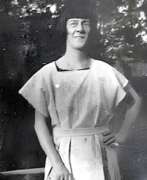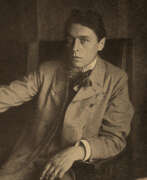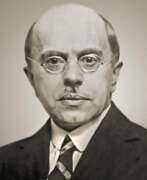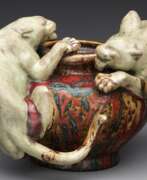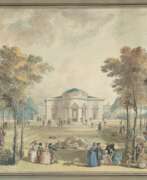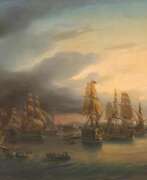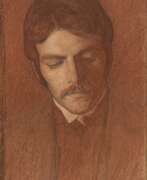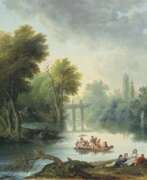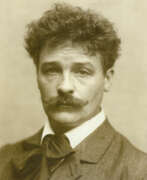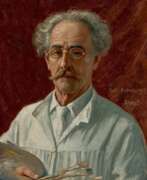Designers 19th century


Louise Abbéma was a French painter, sculptor, and designer, celebrated for her work during the Belle Époque. Born in Étampes in 1853 into an affluent Parisian family, she became well known for her portraits, particularly of the famous actress Sarah Bernhardt, and for decorative panels commissioned for various public buildings in Paris and the Palace of the Governor in Dakar, Senegal.
Abbéma's art often depicted the upper echelons of French society and reflected the Impressionist style through her light and rapid brushstrokes. She was also notable for her involvement in the women's movement, where she contributed to the emerging image of the 'New Woman' by portraying androgynous figures and themes of intellectualism and freedom.
Among her many honors, Abbéma was awarded the Palme Academiques in 1887, nominated as the Official Painter of the Third Republic, and in 1906, she became a Chevalier of the Legion of Honour. Her works, such as "Lunch in the Greenhouse" and "Portrait of Sarah Bernhardt," have seen a resurgence in popularity as the contribution of women to historical art gains more recognition.
For those interested in the evocative and historically rich artworks of Louise Abbéma, consider subscribing to our updates. We'll keep you informed about new sales, auctions, and exhibitions featuring Abbéma's work, ensuring you're always connected to the latest offerings in the art and antique collectors' sphere.


Erik Gunnar Asplund was a Swedish architect, mostly known as a key representative of Nordic Classicism of the 1920s, and during the last decade of his life as a major proponent of the modernist style which made its breakthrough in Sweden at the Stockholm International Exhibition (1930). Asplund was professor of architecture at the Royal Institute of Technology from 1931. His appointment was marked by a lecture, later published under the title "Our architectonic concept of space." The Woodland Crematorium at Stockholm South Cemetery (1935-1940) is considered his finest work and one of the masterpieces of modern architecture.


Leon Bakst (Russian: Лев Самойлович Бакст) was a prominent Russian painter and stage designer, celebrated for his innovative contributions to the world of art and theater. Born in the late 19th century, Bakst became a central figure in the cultural renaissance that swept through Russia and Europe, leaving an indelible mark on the visual and performing arts.
Bakst's work is distinguished by its rich use of color, intricate patterns, and imaginative compositions, which brought to life the exotic and often fantastical themes of the ballets and operas for which he designed. His association with the Ballets Russes, a groundbreaking ballet company that performed across Europe and America, solidified his reputation as a visionary artist. The costumes and sets he created for productions like "The Firebird" and "Scheherazade" were celebrated for their creativity and exoticism, influencing not only the world of theater but also fashion and interior design.
His art extends beyond the stage, with paintings and illustrations that capture the same vibrancy and innovation found in his theatrical work. Museums and galleries around the world, including the State Russian Museum in St. Petersburg and the Metropolitan Museum of Art in New York, house his works, allowing art lovers to experience the magic of Bakst's creations.
For collectors and experts in art and antiques, Leon Bakst's work offers a unique glimpse into a transformative period of cultural history, where the boundaries of art and performance were reimagined. His legacy continues to inspire and captivate, making his pieces highly sought after in the art world.
We invite enthusiasts and collectors to sign up for updates on new product sales and auction events related to Leon Bakst. This subscription ensures you remain informed about opportunities to acquire pieces connected to this extraordinary artist's legacy, without any overbearing commitments. Join us in celebrating the enduring impact of Leon Bakst's art and design.


George Barbier was a French artist and illustrator, fashion designer, who influenced the development of the Art Deco movement.
George Barbier studied painting at the École Nationale Supérieure des Beaux-Arts in Paris. Initially he worked as an illustrator for several famous Parisian fashion magazines, and gradually his drawings began to define the style of women's clothing. The emergence of the Art Nouveau style moved Barbier to create luxurious fashions for cabarets, theaters, and movies. He depicted extravagant theatrical costumes with sparkling rhinestones, high headdresses and huge plumes. Barbier created stage costume designs for Diaghilev's famous Russian Ballet.
He also illustrated catalogs and many literary works, including works by Charles Baudelaire and P. Verlaine, and was an author and designer of jewelry.


Marcus Behmer, full name Marcus Michael Douglas Behmer, known by the pseudonyms Marcotino und Maurice Besnaux, is a German artist, graphic designer and illustrator.
Marcus was the son of the painter Hermann Behmer, participated in World War I and painted miniature portraits of fellow soldiers. From 1900 he began to collaborate with Munich periodicals and book publishers. Bemer drew hundreds of drawings and illustrations and published a series of engravings that were recognized and successful. He also designed typefaces.
In 1936, Behmer was convicted of homosexuality and spent a year and a half in prison, where the artist also found the strength to draw. During World War II, almost all of Bemer's creations were lost or destroyed.


Peter Behrens was a seminal figure in modern design and architecture, heralded as the first industrial designer and a pioneer in modernist architecture. Born in Hamburg, Germany, Behrens's influence spanned across various domains, including architecture, industrial design, and graphic design. His holistic design approach was revolutionary, encompassing everything from architectural projects to corporate identities.
Behrens's association with AEG (Allgemeine Elektrizitäts-Gesellschaft) marked a significant chapter in his career. Hired as an artistic consultant in 1907, he crafted a comprehensive corporate identity for AEG, including the iconic AEG Turbine Factory (1909), a hallmark of industrial classicism and modernism. This work is celebrated for its pioneering approach to industrial architecture and design, integrating form and function with unprecedented clarity and coherence.
His architectural ventures displayed a versatility and an evolution of style, from the monumental, stripped classical form seen in the German Embassy in St Petersburg (1912) and the Administration Building for Continental AG in Hannover (1912-1914), to the expressive Brick Expressionism of the Technical Administration Building of Hoechst AG in Frankfurt (1920-1924). Behrens's work in the 1920s, including the design for the 'New Ways' house in Northampton, UK, and contributions to the Weissenhof Estate in Stuttgart, underscored his shift towards New Objectivity and modernist principles.
Moreover, Behrens's educational contributions were profound, with his teaching stints at the Academy of Fine Arts Vienna influencing a new generation of architects, including luminaries such as Ludwig Mies van der Rohe, Le Corbusier, and Walter Gropius, who would themselves go on to define the course of 20th-century architecture.
Behrens's legacy is a testament to the transformative power of design, illustrating how integrated and forward-thinking approaches can redefine our built environment and the objects we use daily. His work remains an essential study for collectors, experts in art and antiques, and anyone interested in the evolution of modern design and architecture.
For updates on exhibitions and auctions featuring Peter Behrens's work, sign up for our newsletter. Stay informed about new discoveries, sales, and events related to this pivotal figure in modern architecture and design.


Gottlieb Bodmer was a German painter of the first half of the nineteenth century. He is known as a portrait painter, designer and lithographer.
Bodmer practiced portrait painting for several years, then took up lithography. His most important work of the time was a lithograph of the Sistine Madonna. For some time the artist stayed in Paris, where he improved his technique. He copied engravings, and was especially fond of reproducing paintings by artists of the Munich art school. Bodmer's achievements in lithography laid the foundation for the Bavarian lithographic school, which made Munich famous as the "lithographic capital of Germany".


Frank William Brangwyn was a Welsh artist, painter, watercolourist, printmaker, illustrator, and designer.
As well as paintings and drawings, he produced designs for stained glass, furniture, ceramics, glass tableware, buildings and interiors, was a lithographer and woodcutter and was a book illustrator. It has been estimated that during his lifetime Brangwyn produced over 12,000 works. His mural commissions would cover over 22,000 sq ft of canvas, he painted over 1,000 oils, over 660 mixed media works (watercolours, gouache), over 500 etchings, about 400 wood-engravings and woodcuts, 280 lithographs, 40 architectural and interior designs, 230 designs for items of furniture and 20 stained glass panels and windows.




Umberto Brunelleschi was an Italian artist. He studied at the Accademia delle Belle Arti in Florence and moved to Paris in 1900 with Ardengo Soffici where he soon established himself as a printer, book illustrator, set and costume designer.




Frederick Carder was an English-born artist and designer who is best known for his work in glassmaking and his role in co-founding the Steuben Glass Works in the United States. He was a prominent figure in the American art glass movement and made significant contributions to the field.
In 1903, Carder immigrated to the United States and eventually settled in Corning, New York. In collaboration with Thomas G. Hawkes, he co-founded the Steuben Glass Works in 1903. Carder served as the artistic director and chief designer of Steuben for several decades. Under his guidance, Steuben became renowned for producing high-quality art glass known for its elegance, craftsmanship, and innovative designs.
Carder experimented with various glass-making techniques and was skilled in creating a wide range of glass objects, including vases, bowls, lamps, and tableware. His designs showcased a diverse range of styles, from delicate and intricate Art Nouveau-inspired pieces to bold and modern Art Deco designs. Carder's work often featured vibrant colors, intricate patterns, and intricate glass techniques such as iridizing and acid etching


Louis Carrogis, better known as Carmontelle was a French artist, garden designer, architect, playwright and inventor.
Carmontelle was of simple origins but versatilely gifted. He wrote several plays and three novels, and created portraits of historical figures. He became famous for his painting of little Mozart at the clavier. In the service of Louis-Philippe I, Duke of Orléans, he was responsible for the theatrical performances for the family as stage designer and stage director.
Carmontelle is the planner and designer of one of the earliest examples of a French landscape garden in Paris, now known as Parc Monceau. In designing the garden, Carmontel rejected many of the fashionable trends in landscape design at the time, drawing inspiration from Japanese pleasure gardens and insisting on incorporating illusion and fantasy.
Carmontelle is also credited as the inventor of animated images. Translucent tape with landscapes depicted on it was slowly rolled from one roll to another against a backdrop of daylight, thus creating the illusion of walking through a garden.


Adolf Iosifovich Charlemagne (Russian: Адольф Иосифович Шарлемань) was a renowned Russian painter, born in 1826 in Saint Petersburg. He excelled in historical, genre, and battle scenes, deeply influenced by his artistic lineage—his father was an architect and his grandfather a sculptor. Educated at the Imperial Academy of Arts under Fyodor Bruni and Bogdan Willewalde, Charlemagne's works are celebrated for their historical accuracy and intricate details.
Charlemagne's notable works include "The Capture of Kazan by Ivan the Terrible" and "The Battle of Kulikovo," which vividly capture significant moments in Russian history. His paintings are known for their meticulous attention to detail, dramatic compositions, and ability to convey the emotional intensity of historical events. These masterpieces are housed in prestigious Russian museums, showcasing his contributions to Russian cultural heritage.
Throughout his career, Charlemagne received numerous accolades, including the titles of Academician and Professor at the Imperial Academy of Arts. His dedication to historical accuracy and artistic excellence made him a prominent figure in Russian art.
For collectors and enthusiasts, owning a piece by Adolf Iosifovich Charlemagne means acquiring a significant part of Russian history. To stay updated on new product sales and auction events related to Charlemagne's works, sign up for our updates today.


Hans Christiansen was a German painter, representative of classical modernism, decorator and illustrator.
Christiansen trained as a decorative painter in Flensburg and then at the School of Applied Arts in Munich, later studying at the Académie Julian in Paris. After a study trip to Italy in 1889, he moved to Hamburg, where he taught at the Technical University.
At the same time, Christiansen worked as a freelance decorative artist and was active in the Volkskunst-Verein, and was one of the founders and first residents of the Darmstadt artists' colony of the late 19th and early 20th century. Together with Josef Olbrich and Peter Behrens, he designed furniture, ceramics, tapestries, stained glass and graphic posters. He also designed his own house in the colony, which he called "Villa Rose," which was destroyed during World War II.
During this time, the versatile artist also wrote regularly for the magazine Jugend, creating many illustrations and covers. From 1911 he lectured at the Wiesbaden School of Arts and Crafts and was a member of the Wiesbaden Free Artists Association.
In 1933, Christiansen's work was banned by the Nazi Party of Germany because of his Jewish wife, and he was almost forgotten until his death in 1945.


Charles Edouard De Beaumont was a French realist painter, watercolourist and lithographer.
Beaumont illustrated classic books of his era and was a regular and very popular contributor to Parisian periodicals. He is widely known for his humorous and sometimes satirical scenes of Parisian life.


Fortunato Depero was an Italian futurist painter, designer, sculptor and poet. In 1913 Depero comes to Rome, where he meets the futurists Giacomo Balla and Umberto Boccioni.
In the early 1920s, Fortunato Depero tries his hand as an artist in commercial advertising, designs theatrical costumes, works for magazines and as a room decorator, and participates in many art exhibitions.


Jean-Charles Develly is a French designer and artist. He is particularly famous for his paintings on porcelain while working at the Sèvres factory. Jean-Charles Develly worked at the Porcelain Manufactory in Sevres from September 1813 to 1847 and became one of the most famous artists of this establishment.


Raoul Dufy, a renowned French artist, is celebrated for his vibrant and decorative style, which left a significant mark in the realms of Fauvism and Post-Impressionism. Born in 1877 in Le Havre, France, Dufy's artistic journey was profoundly influenced by Henri Matisse's Fauvist work "Luxe, Calme et Volupté," which he encountered at the Salon des Indépendants in 1905. This experience steered him towards Fauvism, a style that emphasized bold contours and bright colors.
Dufy's artistic evolution saw him briefly embrace Cubism around 1920, after which he developed a unique approach. This approach, often referred to as stenographic, was characterized by skeletal structures, foreshortened perspectives, and the use of thin, quickly applied washes of color. His works, known for their cheerful and fashionably decorative nature, often depicted scenes of leisure like yachting, the French Riviera, and chic parties, capturing the essence of the period's optimism.
In addition to his painting, Dufy was also a commercial artist, illustrator, and designer, contributing significantly to textile design and public murals. His large-scale public art commissions combined modern and allegorical subjects with exuberant outlines and intense colors, showcasing a modernist take on traditional mural work. Notable works by Dufy include "The Regatta," "The Harvester," and the monumental "The Electricity Fairy," a large mural commissioned for the 1937 World's Fair in Paris.
His works are housed in prestigious public collections worldwide, including the Art Institute of Chicago, the Musée d'Art Moderne de Paris, and the National Gallery of Art in Washington, D.C. Despite his artistic achievements, Dufy's focus on decorative art and the lack of engagement with wider social concerns has led to a varied critical reception of his work. Nonetheless, his contribution to 20th-century art, particularly in popularizing a vibrant and illustrative style, remains undisputed.
If Raoul Dufy's artistry captivates you and you wish to stay informed about the latest artworks, exhibitions, and auction events related to this remarkable artist, we invite you to sign up for our updates. By subscribing, you'll receive timely notifications about new pieces for sale and upcoming auctions. This is a wonderful opportunity for collectors and art enthusiasts to enhance their appreciation and possibly their collections of Dufy's work. Stay connected with the world of art and don't miss any chance to acquire unique pieces by this celebrated artist.


Edmund Dulac is a British and French artist, book illustrator and graphic artist.
Edmund drew a lot since childhood and, after graduating as a lawyer, decided to take up art: he studied at the Toulouse Academy of Fine Arts and at the Academy of Julian. At the age of 22, he settled in London and received an order from the publisher J. M. Dent to illustrate the novel "Jane Eyre" and other works of the Brontë sisters. He then became a regular contributor to Pall Mall Magazine and joined the London Sketch Club, where he met the leading book and magazine illustrators of the day.
These acquaintances opened a wide road for the young talented artist. Dulac decorated many editions of Andersen's fairy tales, works by Shakespeare, Edgar Poe, Omar Khayyam and others with his magical pictures. Working with the famous animator Walt Disney, he participated in the development of the type of Snow White, and his most famous work is considered the image of the Princess Boudour.
Later, Dulac worked in a variety of fields, including newspaper cartoons, theatrical costumes and sets, medals, and even postage stamps, including those commemorating the coronation of King George VI (1937), the beginning of Queen Elizabeth II's reign, and the Summer Olympics (1948).


William Dunlap was an American playwright, theater director, artist, and historian.
William Dunlap was a pioneer of the young country's theater. He directed two of New York City's earliest and most famous theaters, the John Street Theater and the Theater in the Park. During his lifetime he directed over sixty plays, most of which were adaptations or translations of French and German works. But among them were some original ones based on American themes with American characters.
In 1832 Dunlap published A History of the American Theater in two volumes. In 1825, Dunlap co-founded the National Academy of Design and taught at its school. Even today, Dunlap is best known for his encyclopedic three-volume History of the Origin and Progress of the Art of Design in the United States. The book was published in 1834 and is now an invaluable source of information about artists, collecting, and artistic endeavors in the country of that historical period.


Fritz Helmuth Ehmcke was a German graphical designer, typographer and illustrator. Ehmcke was educated as a lithographer in Berlin during 1893–1897. In 1900, he was a co-founder of Steglitzer Werkstatt. From 1903, he taught at the Kunstgewerbeschule in Düsseldorf, from 1913 to 1938 in Munich, during 1920-1921 also in Zürich. During 1946 to 1948, he was professor at the Academy of Fine Arts, Munich. He designed a number of typesets, notably Ehmcke-Antiqua and Ehmcke-Kursiv in 1909/10 (adopted for English-language typesetting by Stephenson Blake under the name Carlton).


Aleksandra Aleksandrovna Ekster (Russian: Алекса́ндра Алекса́ндровна Эксте́р), a luminary of the Russian avant-garde, was a painter and designer whose work traversed the boundaries of Cubo-Futurism, Suprematism, and Constructivism, eventually influencing the Art Deco movement. Born in Białystok (then part of the Russian Empire, now Poland) and later splitting her life among Kiev, St. Petersburg, Moscow, Vienna, and Paris, Ekster played a pivotal role in bridging Russian and European artistic movements. Her innovative approach to art was characterized by dynamic movement, vibrant color contrasts, and geometric compositions, which were evident in her paintings, theater set and costume designs, and educational endeavors.
Ekster's studio became a hub for the intellectual and artistic elite, hosting figures like poets Anna Akhmatova and Osip Mandelstam, as well as painters Pablo Picasso and Georges Braque during her stays in Paris. Her involvement in significant art exhibitions, such as the Salon des Indépendants and the Salon de la Section d'Or in Paris, showcased her works alongside those of Jean Metzinger, Marcel Duchamp, and others, marking her as a key figure in the avant-garde community.
Beyond painting, Ekster's contributions to theater and design were profound. She worked on costume and set designs for Alexander Tairov's Chamber Theatre and participated in the revolutionary festivities' decoration in Kiev and Odessa. Ekster's pedagogical efforts included teaching at the Higher Artistic-Technical Workshop (VKhUTEMAS) in Moscow, fostering a new generation of avant-garde artists.
Ekster's work is housed in various international and private collections, reflecting her lasting impact on the art world. Her ability to integrate different genres and styles, along with her commitment to experimentation and innovation, made her one of the most influential women in the Russian avant-garde.
For those fascinated by the pioneering spirit of Aleksandra Aleksandrovna Ekster and the avant-garde movement, signing up for updates on new product sales and auction events related to her work is a compelling way to stay informed. This subscription ensures enthusiasts and collectors are always in the loop regarding opportunities to engage with Ekster's enduring legacy.


Fritz Erler was a German painter, graphic designer and scenic designer. Although most talented as an interior designer, he is perhaps best remembered for several propaganda posters he produced during World War I.
During the National Socialist period Erler's portraits of Adolf Hitler, Franz von Epp, and Wilhelm Frick were very remunerative.


Albert Henry Fullwood was an Australian artist who made a significant contribution to art in Australia. He painted with Heidelberg School artists around Melbourne and moved to live and paint at their camp in Sirius Cove, Sydney. Fullwood was the Australian official war artist to the 5th Division in the World War I. Fullwood is represented in numerous galleries.


Eugène Gaillard was a French art nouveau industrial designer, architect and advocate of modern design. Gaillard abandoned a career in law for that of interior design and decoration. He was employed for some time by Siegfried Bing along with Georges de Feure and Edouard Colonna to work on his pavilion at the 1900 Paris Universal Exposition.


Akseli Gallen-Kallela, born Axel Waldemar Gallén, is a Finnish artist of Swedish descent.
He studied at the Académie Julian in Paris, traveled to Africa, and later designed flags, coats of arms and uniforms for the army of independent Finland.
Akseli Gallen-Kallela is a representative of Finnish National Romanticism and Northern Art Nouveau painting from 1880-1910. In his work he used symbolism and artistic techniques of Art Nouveau style. The unvarnished depiction of disease, suffering and social hardship was part of the naturalistic conception of art that Gallen-Kallela followed from the beginning of his career. He frequently painted the harshness of life, often with elements of Christian symbolism.


Walter Gay was an American artist known for his elegant, understated paintings of interiors and still lifes. He was studied at the School of the Museum of Fine Arts in Boston before traveling to Paris to continue his education at the Académie Julian.
Gay was part of a group of American artists who were drawn to Paris in the late 19th century, and he became associated with the expatriate community of American and British artists who settled in the city's Montparnasse district.
Gay's paintings are characterized by their subtle color harmonies, refined composition, and attention to detail. He specialized in depicting elegant, tastefully appointed interiors, often featuring antique furniture, works of art, and architectural details. He was also known for his still lifes, which included simple arrangements of flowers, fruit, and other objects arranged on tabletops or in windowsills.
Gay's work was highly sought after by collectors during his lifetime, and he exhibited regularly in Paris, London, and New York. He was awarded the Legion of Honor by the French government in 1908 in recognition of his contributions to the arts. Today, his paintings can be found in the collections of museums around the world, including the Metropolitan Museum of Art in New York and the Musée d'Orsay in Paris.


Alexander Gerbig was a German expressionist painter, graphic artist and decorative artist.
Gerbig worked successfully as a decorative painter, studied at the Royal School of Arts and Crafts in Dresden and later at the Royal Academy of Arts in Dresden, traveled Europe on study tours, and won various awards for his paintings.
He served as a soldier during World War I and made numerous sketches of the events he witnessed. In the 1920s Gerbig held several successful exhibitions and actively socialized with almost all art associations of the time. During the years of National Socialist rule in Germany, Gerbig's work was declared degenerate, his paintings were withdrawn from museums and he was forbidden to paint. In 1945, however, he became honorary chairman of the visual arts section of the Zuhl Cultural Association.


Charles March Gere was an English painter, illustrator of books, and stained glass and embroidery designer associated with the Arts and Crafts movement.
A member of the Birmingham Group of Artist-Craftsmen that formed around Joseph Southall, Gere taught at the Birmingham School of Art under Edward R. Taylor and illustrated many books for William Morris's Kelmscott Press, including the frontispiece of Morris's own News from Nowhere.


Aleksandr Yakovlevich Golovin (Russian: Алекса́ндр Я́ковлевич Голови́н) was a distinguished Russian artist and stage designer, celebrated for his vibrant and ornate creations in the realms of theatre and fine arts. Born in Moscow in 1863, Golovin initially pursued architecture before shifting his focus to painting, a move that enriched Russian art with his unique blend of symbolism and modernism. His academic journey took him from the Moscow School of Painting, Sculpture and Architecture to the Académie Colarossi in Paris, marking the beginning of a prolific career that intertwined Russian heritage with avant-garde European influences.
Golovin's artistic signature is evident in his stage designs for prominent figures like Sergei Diaghilev, Constantin Stanislavski, and Vsevolod Meyerhold. His work for the original production of Stravinsky's "The Firebird" ballet and the scenic design for Beaumarchais's "The Marriage of Figaro" at the Moscow Art Theatre showcases his ability to blend visual splendor with dramatic storytelling. Beyond the theatre, Golovin's paintings, such as portraits of Fyodor Chaliapin and Vsevolod Meyerhold, and works like "Porcelain and flowers" and "Silver willows," display his mastery over color and form, capturing the essence of Russian culture and the beauty of the natural world.
A figure of national pride, Golovin was honored as a People's Artist of the RSFSR, a testament to his significant contribution to Russian art and culture. His legacy continues to inspire, with his works preserved in the Russian Museum among other collections, serving as a testament to his enduring influence on Russian artistic expression.
For collectors and experts in art and antiques, Aleksandr Yakovlevich Golovin represents a pivotal figure in the evolution of Russian visual arts and stage design. His contributions to both fields remain invaluable, reflecting a unique blend of cultural heritage and innovative artistry. For updates related to Golovin, including new product sales and auction events, signing up for updates offers an exclusive insight into the world of this remarkable artist.


Johann Georg Grimm was a German painter of the mid-nineteenth century. He is known as a landscape painter and designer, most famous for his works created during his stay in the Brazilian Empire.
Georg Grimm is recognized as the preeminent master of Brazilian art and is considered a leader of modernism in that country. He had a significant influence on the development of modern painting in Brazil, founding a plein air school and becoming a teacher. His naturalistic landscapes are recognized as a valuable legacy and many are in private collections. In Germany he remained little known.


Walter Adolph Georg Gropius was a German-American architect, recognized as one of the founding masters of modern architecture and the pioneer behind the Bauhaus School. Born in Berlin, Gropius was immersed in an environment that nurtured his architectural interests from an early age, thanks to his well-connected family and architect great-uncle, Martin Gropius. His education took him from Munich to Berlin, where he honed his architectural vision, eventually joining the office of Peter Behrens, where he worked alongside future luminaries such as Ludwig Mies van der Rohe and Le Corbusier.
Gropius's early career saw him co-found an architectural practice with Adolf Meyer, with whom he created the Fagus Factory, a landmark in modern industrial architecture that emphasized the form follows function principle and showcased modernist design through its glass curtain walls. This period was marked by his contributions to the Deutscher Werkbund, advocating for the fusion of art with industrial design, and his leadership at the Bauhaus School, where he fostered an interdisciplinary approach to art and design education.
His relocation to the United States led to significant projects, such as the Harvard Graduate Center and the Josephine M. Hagerty House, marking his influence on American architecture and the broader acceptance of International Modernism. Gropius's legacy is not only in his buildings but also in his philosophy of integrating art, design, and architecture, a vision that continues to inspire architects worldwide.
For those interested in exploring the works and impact of Walter Gropius further, visiting exhibitions at museums or galleries that feature his work and the Bauhaus movement can offer deeper insights. Collectors and experts in art and antiques might find his approach to design and architecture particularly enlightening, given its enduring influence on modern and contemporary art.
If you're captivated by the innovation and ideas of Walter Gropius and wish to stay informed about sales, auctions, or exhibitions related to his work, consider signing up for updates. This subscription will ensure you're always in the know about events and opportunities related to this pioneering figure in modern architecture.


Paul Guignebault, born Paul Amand Guignebault, is a French painter, illustrator, designer and printmaker.
Paul studied at the Paris School of Fine Arts. In early 1902, he founded L'Atelier d'art with Henri Boutet, where they printed fine prints and color etchings. Paul Guignebault also worked as an illustrator of works for children for several book publishers in Paris, and was also involved in the creation of picture reproductions for Imagerie Quantin.


Albert Pieter Hahn was a Dutch political cartoonist, poster artist and book cover designer; well known for his socialist and antimilitaristic viewpoints. Some of his drawings, especially those of the railroad strikes of 1903, have been regularly used in history textbooks. His son-in-law, Albert Hahn jr., was also an artist, so he is sometimes referred to as "Sr.".


John Hassall was an English illustrator, known for his advertisements and poster designs. In 1895, he began work as an advertising artist for David Allen & Sons, a career which lasted fifty years. Between 1896 and 1899 alone, he produced over 600 theatre poster designs for this firm while, at the same time, providing illustrations to several illustrated newspapers. Making use of flat colours enclosed by thick black lines, his poster style was very suitable for children's books, and he produced many volumes of nursery rhymes and fairy stories, such as Mother Goose’s Nursery Rhymes.


Frans / Franz Hens was a Belgian post-impressionist painter, draftsman and printmaker. He was one of the first European artists to paint in Sub-Saharan Africa. He was a member of several artists' associations, including Pour l'Art and Weest U Zelve (Be Yourself) and was a founding member of De XIII and Kunst van Heden (Art of Today). From 1919 to 1923, he was a teacher at the Royal Academy. Despite the prominence given to his African paintings, most of his work was focused on the Belgian coast, with ships as a recurring theme.


Johann Caspar Herterich was a German painter of the last third of the nineteenth century. He is known as a historical and genre painter, as well as a teacher at the Royal Academy of Fine Arts in Munich.
Herterich created a number of portraits in addition to canvases on historical, religious and genre themes. His works included dramatic scenes, sentimental genre scenes from family life. The artist actively participated in the Arts and Crafts movement and was involved in designing chandeliers and other decorative elements. Among the master's pupils was his younger brother Ludwig von Herterich, who also became a famous artist.


Olle Hjortzberg, or Gustaf Olof Hjortzberg, is a Swedish painter, illustrator, and designer.
He studied at the Swedish Royal Academy of Arts, then traveled to Palestine, Syria and Greece.
Hjortzberg is known primarily as the author of colorful floral still lifes, but he also painted St. Katharina's Church in Stockholm and the cathedral in Uppsala and was a professor at the Royal Academy of Fine Arts. The artist illustrated the Bible and drew posters and stamps.
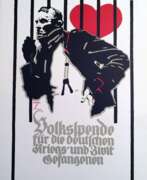





Vojtěch Adalbert Hynais was a Czech painter, designer and graphics artist. He designed the curtain of the Prague National Theatre, decorated a number of buildings in Prague and Vienna, and was a founding member of the Vienna Secession. He was made an Officer of the Légion d'honneur in 1924.


Marcel Jefferis is a Belgian Impressionist painter. He painted figures, genre scenes, landscapes and still lifes in oils and watercolors, and made etchings. His paintings often depict festive demonstrations with many characters. He also designed furniture, wallpapers, fabrics, tapestries and interiors for the Vanderborght company in Brussels.


Owen Jones was a British architect, designer, theorist and decorative arts artist.
Educated at the Royal Academy, Jones traveled to the Middle East and Spain between 1833 and 1834, studying the architecture and design of the Islamic and especially the Arab world. Jones dedicated his work Plans, Facades, Sections, and Details of the Alhambra (1842-45) to the famous palace at Granada, an outstanding example of Moorish architecture.
Jones is also known for his work on Eastern and Western design motifs, Grammar of Ornament (1856), which is a systematic pictorial compendium emphasizing the use of color and the application of logical principles in the design of carpets, wallpaper, furniture, and interior decoration.


Jessie Marion King was a Scottish illustrator known for her illustrated children's books. She also designed bookplates, jewellery and fabric, and painted pottery. King was one of the artists known as the Glasgow Girls.
King was influenced by the Art Nouveau of the period, and her works correspond in mood with those of The Glasgow Four. Despite the influence of Art Nouveau, she was inspired to create unique designs where she did not literally translate the real world.
Most of King's earliest works involved illustration, but she also wrote books and was a skilled jewellery designer.
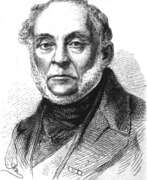

Carl Friedrich August von Kloeber was a German painter of the first half of the 19th century. He is known as a painter and teacher, a member of the Berlin Academy of Arts.
August Kloeber preferred to use motifs from mythology in his works, which distinguished him from many German artists of the time. He also created paintings on religious and historical subjects. He also painted portraits, and his models included members of Beethoven's family. Kloeber received commissions from the Prussian royal family and worked on the painting of castles, churches, and other sites. He also designed porcelain, jewelry, and medals.


Otto Albert Koch was a German painter of the late nineteenth and early twentieth centuries. He is known as a historical and genre painter, as well as a master of watercolor painting.
Otto Albert Koch created genre paintings, works on mythological and historical themes, as well as landscapes. He became famous, in particular, for his painting "Triumphal Procession of Bacchus". The artist was also engaged in advertising graphics and the creation of posters. He was one of the founders of the Free Community of Baden-Baden Artists.


Max Koner was a German painter of the late 19th century. He is known as a portrait painter.
Max Koner began his career with landscapes, but then switched to figure painting and especially portraits. He painted more than 100 portraits, including thirty portraits of Kaiser Wilhelm II. His clients were not only the imperial court, but also other aristocratic families, famous artists, scholars and the elite of Berlin society. Koner was one of the most sought-after artists of his time and received design commissions from Stolwerk, a chocolate manufacturer in Cologne.


























